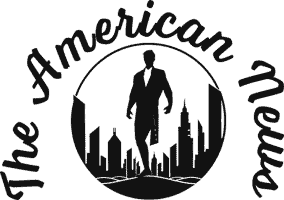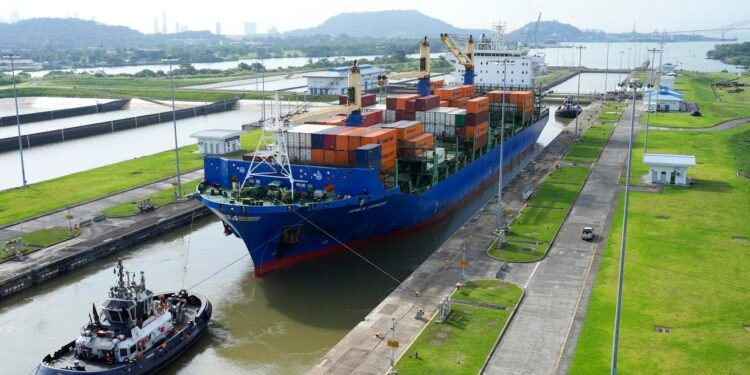A cargo ship and tugboat sail through the Cocoli Locks at the Panama Canal, in Panama, on August 12, … [+] 2024. Next August 15 the Panama Canal celebrates its 110th inauguration anniversary. (Photo by ARNULFO FRANCO / AFP) (Photo by ARNULFO FRANCO/AFP via Getty Images)
AFP via Getty Images
Secretary of State Marco Rubio’s visit to Panama signaled a clear message: the U.S. is determined to reassert its influence in Latin America and the Caribbean amidst the People’s Republic of China’s expanding reach, while navigating complexities with a region that has continuously turned to Beijing for economic partnerships and investment. However threatening partners, while a short term tactical approach, will not prove to be a long term strategy for better engaging economically with the region.
A Shifting Diplomatic Landscape
TOPSHOT – U.S. Secretary of State Marco Rubio (L) shakes hands with Panama Canal Authority … [+] Administrator Ricaurte Vasquez during a tour at the Miraflores locks of the Panama Canal in Panama City on February 2, 2025. Rubio arrived on the eve on his debut trip abroad as US secretary of state, as he looks for how to follow up on President Donald Trump’s extraordinary threat to seize the Panama Canal. (Photo by Mark Schiefelbein / POOL / AFP) (Photo by MARK SCHIEFELBEIN/POOL/AFP via Getty Images)
POOL/AFP via Getty Images
Rubio made a calculated choice by traveling first to Panama and Central America as secretaries of state typically start their term traveling to Europe, Middle East, or even Asia to fortify their alliances. However, Rubio’s first trip reflects a change in emphasis as PRC influence in Latin America continues to increase. He also made a special visit to The Panama Canal.
What’s At Stake? Trade And Investment And The Panama Canal Allows For Much Shorter Shipping Routes
Distance ship vessels save travelling through the Panama Canal
Council on Foreign Relations_ Sea Distance .org
The PRC has invested heavily in infrastructure projects, such as building a $1.3 billion port terminal on the Atlantic side of the Panama Canal, part of the PRC trying to establish itself in the Western Hemisphere. In 2023, the U.S. was Panama’s largest trade partner exporting a total of $5.29 billion into Panama, and $385 million in imports into the U.S. In comparison, China’s exports to Panama equaled to $4.43 billion and $385 million in imports to China. Now, while the U.S. remains as the top trading partner for Panama, the PRC has been increasing trade especially in key sectors such as technology and infrastructure.
Growth of Exports from China to Panama (2018-2023) and Growth of Exports from Panama to China … [+] (2018-2023)
Observatory of Economic Complexity
The United States finds this increasing influence in its own backyard to be a worrying trend. Rubio used his trip to remind Latin American countries that, despite the attraction of PRC investments, the United States is still a vital partner in the region, especially in Panama, a vital entry point for international trade. President Trump’s “America First” foreign policy, which has frequently been criticized for emphasizing U.S. national interests and security over the long-term relationships that have historically defined U.S.-Latin American ties, makes the visit especially noteworthy. However, it appears that Rubio’s diplomatic outreach aims to provide a more nuanced strategy that strikes a balance between the need for stronger regional partnerships and American interests.
Does China Control The Panama Canal?
Replica of the Sea Witch Clipper which travelled from China to Panama carrying 705 Chinese laborers … [+] on March 30th 1854 who were instrumental in building the Panama Canal.
Earl A. Carr Jr.
The Chinese have a long history in Panama. On March 30, 1854, The Sea Witch Clipper arrived to Panama with 705 Chinese to work in the transoceanic railroad which was critical for constructing the Panama Canal. Over 171 years later, Trump states that “China is running the Panama Canal.” However Dr. Vasquez, CEO & Canal Administrator and Alberto Aleman former Administrator of the Panama Canal Authority (PCA), both refuted claims that the Panama Canal is controlled by China. In a Woodrow Wilson sponsored event Alberto Aleman was asked by John Feeley former US Ambassador to Panama, did the Panama Canal Authority ever consult with Chinese government officials to which he responded “no, only Chinese companies and we couldn’t because we didn’t have diplomatic relations with China.” China and Panama established diplomatic ties in 2017.
What many don’t know is that the PCA is actually an autonomous apolitical authority in which Panama changed its constitution so that irrespective of which political party is in power, the Panama canal should remain politically neutral.
Narrative sign inside the Canal which describes the various laborers and the countries they … [+] represented to build the canal: “Most came from Barbados, but also from Martinique, Guadeloupe, Trinidad and Jamaica. Spanish, Italians, Greeks, Hindus, Americans, Armenians, Cubans, Costa Ricans, Colombians and Panamanians contributed to this effort”
Earl A. Carr
Its primary goal is to provide consistent, safe, efficient and uninterrupted transit for international trade. No foreign entity, Chinese or other, controls the Canal. Because of this and other factors, PCA currently has a higher credit rating than the Republic of Panama. (A3/BBB+/WD vs. Baa3/BBB-/BB+).
At the heart of this controversy is CK Hutchison, a company with a history dating back two centuries that is owned by Hong Kong’s richest man. According to the Federal Maritime Commission, the company operates infrastructure assets around the world — including port terminals at the Atlantic and Pacific ends of the canal, through which 40 percent of U.S. container traffic transits annually. Rubio being interviewed on Sirius XM’s The Megyn Kelly Show said that if the Chinese Communist Party told Hutchison to shutdown the Port in Panama they would be forced to comply. However, Hutchison does not own the land in the ports and does not have the legal authority to do, moreover it conflicts with the treaty of neutrality.
Countering PRC Influence
TOPSHOT – Crew members of Chinese Cosco Shipping Rose container ship wave Chinese and Panamenian … [+] flag before China’s President Xi Jinping and Panama’s Juan Carlso Varela, arrive at the Cocoli locks in the expanded Panama Canal, in Panama City, Panama on December 3, 2018. – Chinese President Xi Jinping is on an official visit to Panama after attending the G20 Summit in Argentina. (Photo by LUIS ACOSTA / AFP) (Photo by LUIS ACOSTA/AFP via Getty Images)
AFP via Getty Images
In reaction to Trump’s harsh rhetoric, Panamanian President Jose Raul Mulino, who has long attempted to maintain a pro-American position, has recently found himself balancing a tightrope. Panama will continue to control the canal as Mulino has assured the world’s leaders and citizens. However, the United States is increasing pressure on the Panamanian government due to the ongoing rise in PRC influence in the country with a potential risk to the Panama Canal.
This decision reflects the larger context of U.S.-China relations, where Washington has been alarmed by China’s ambitions to expand its political and economic influence. As a vital hub for trade routes and a significant part of the global economy, Latin America has become a major battleground in this global struggle. During Rubio’s visit, the U.S. was able to reassure Latin American countries that they are not being overlooked in favor of priorities that are farther away.
Latin America Perceptions
People demonstrate against US President-elect Donald Trump at the Monument to the Martyrs of January … [+] 9th and the “eternal flame” in Panama City on December 31, 2024, as the country marks the 25th anniversary of the United States’ handover of the interoceanic Panama Canal to Panama. (Photo by ARNULFO FRANCO / AFP) (Photo by ARNULFO FRANCO/AFP via Getty Images)
AFP via Getty Images
Latin America has responded differently to the Trump administration’s “America First” stance. There has been disagreement among the region’s leaders and local citizens alike, with some voicing extreme discontent at Trump’s strict positions on trade, immigration, foreign aid, and notions that The US can take the Panama Canal back. Robin Dudley, an entrepreneur and CEO of DesignLab who lives in Panama says, “There is absolutely no legal basis by which The U.S. can take the Panama Canal back; Trump is relying on lies. This is a fight between David and Goliath, but we as Panamanians will emerge stronger because we have God and the truth on our side.”
Given that Trump’s border security proposals frequently jeopardize diplomatic efforts in the region, the harsh rhetoric regarding immigration in particular has caused a great deal of tension with Latin American leaders. Claudia Sheinbaum, Mexico’s President was prepared to implement reciprocal tariffs when she negotiated with Trump.
Rubio’s visit does, however, present a chance to rebalance U.S.-Latin American ties. Despite being deeply anchored in American interests, his strategy should have been more pragmatic than the combative approach that-characterizes Trump’s presidency. Rubio reassured leaders in Latin America that the United States is still dedicated to working together by concentrating on regional alliances and thwarting China’s influence. However it is also critical that the US and China can and should cooperate when their national interests align. Developing frameworks to work with China and other nations to provide humanitarian relief impacted by natural disasters or global pandemics is in the interest of all of humanity.
Assessing The Success
In the end, what did Rubio get? The U.S.’s ability to increase its economic and security alliances with Panama and other Central American countries, as well as Rubio’s ability to persuade these nations to reevaluate or reduce their economic connectivity with China, are important short term success factors.
However, the true long term effectiveness of Rubio’s visit will depend on the United States’ overall capacity to reestablish a congenial relationship in the Latin America & The Caribbean. This will necessitate not only financial incentives, but more of an all-encompassing strategy for regional economic development that tackles problems such as migration, poverty, and corruption—concerns that have long been sources of instability in the region and which USAID has been uniquely positioned to. China is has already initiated filling a void left behind by the Trump administration’s abrupt retrenchment of USAID. “China is already reaching out to partners,” in an interview with Politico said Francisco Bencosme, who served as USAID’s China policy lead during the Biden administration.
While Panama is the first country to publicly withdraw from China’s Belt and Road Initiative, that does not mean it could not easily rejoin in the future. It will also be crucial to evaluate how the leaders of the region react to the “America First” policy. Will they view it as a diplomatic misstep or a reaffirmation of U.S. strength in the region? President Mulino, continues to exercise caution in juggling Panama’s demands with American expectations.
Policy Recommendations For The U.S.
To strengthen its stance and reputation in the LAC, the U.S. should prioritize policy that builds robust trade and investment relationships with the region, rather than focusing on limiting its partner’s access to trade freely and build their own relationships. In an interview with WLRN, Leland Lazarus Associate Director at Florida International University notes, “over the past several decades, Latin America and the Caribbean has been deprioritized in terms of U.S. engagement.”
A collaborative approach is necessary and in particular a realignment of lending regulations to enable institutions like the U.S. Development Finance Corporation (DFC) to provide financial support to countries like Panama. Currently, International Financial Institutions (IFI’s) are prohibited from lending to countries which according to The World Bank are deemed to be “high income standards.” The World Bank defines a high-income economy as a nation with a gross national income (GNI) per capita of at least $14,005. So what this means is that even though Panama has one of the highest income inequalities in the world DFC and other institutions are prohibited from lending there. Gerard Johnson, former General Manager of the Inter American Development Bank says that, “American developing finance institutions like The DFC should delink from the World Bank high income standards as these are arbitrary and outdated.” Such a proposal is certainly gaining momentum. Finally, removing per capita income as a criterion for eligibility could make said loans more accessible, enhancing a region’s development and securing U.S. influence. The U.S. can better foster the region’s development and preserve its power in the presence of increasing PRC competition by modifying these policies.
Can The U.S. Reclaim The Panama Canal?
View of demonstrators, many with signs and banners, protesting a treaty to return control of the … [+] Panama Canal to Panama, gathered on steps of east entrance of the US Capitol building, Washington DC, September 7, 1977. ( Photo by Warren K Leffler/US News & World Report Magazine Collection/PhotoQuest/Getty Images)
Getty Images
The Panama Canal itself continues to be one of the most controversial topics in U.S.-Panama relations. Although the United States gave up control of the canal in 1999, there has been some discussion about whether or not the U.S. should try to regain control. There would be major diplomatic and legal obstacles to any attempt to change this arrangement, including possible opposition from international organizations, let alone American allies and adversaries.
Over 5% of global trade depends on the Panama Canal, and controlling it has significantly increased Panama’s income. Mulino has emphasized that the Panama Canal has been managed responsibly for 25 years and that Panama’s sovereignty over the canal cannot be compromised. In addition to breaking international law, any attempt by the U.S. to regain control of the canal would have major economic ramifications, possibly destabilizing the area and harming trade ties between the United States and Panama.
The U.S. needs a long-term strategy of better engaging economically with Panama and the region not threatening its partners as it strives to compete with China. Whether the U.S. can continue to have an impact in a region that is becoming more influenced by external factors beyond its control will depend on Rubio’s diplomatic efforts. In the Book “The Art of War author Sun Tzu writes, “If you know the enemy and know yourself, you need not fear the result of a hundred battles.” What the US needs to do most is to better know and grow with Latin American markets and trade.
Special thanks to Roxana Amiot for her exceptional thought leadership, research, and editorial contributions to this article. Thanks to Jonah Kim for assisting with providing info-graphics.
Source link : http://www.bing.com/news/apiclick.aspx?ref=FexRss&aid=&tid=67b6c4c1b0bc4325ab57efba7e9e30a2&url=https%3A%2F%2Fwww.forbes.com%2Fsites%2Fearlcarr%2F2025%2F02%2F18%2Freimagining-us–chinese-influence-in-central-america-critical-implications-for-the-panama-canal%2F&c=8257931805091718780&mkt=en-us
Author :
Publish date : 2025-02-18 01:05:00
Copyright for syndicated content belongs to the linked Source.











